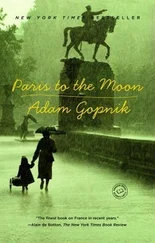Voltaire—not surprisingly, given the Rousseauian rhetoric of the restaurant—thought the whole thing was nuts, and said so. His diatribe against the new cooking, which some academics have insisted on interpreting as an allegorical protest against Communion, now appears to have been actually a diatribe against the new cooking. “I swear that my stomach cannot bear the new cooking. I cannot bear sweetbreads swimming in a salty sauce nor a hash composed of turkey, hare and rabbit, that dreams of being mistaken for a single meat. I don’t like either pigeon in the frog style”—that is, flattened and deboned. “When it comes to cooks, I wouldn’t know how to bear the essence of ham, nor the excess of morels, mushrooms, peppers and muscade, with which they cover meats healthy in themselves.”
It might seem odd that what was meant to be romantically “simple” appeared to a jaundiced Enlightenment eye as needlessly complex—the morels and mushrooms doubtless were defended as striking that healthy country note—until one recalls that this is a standard event in the history of cookery: one need only remember the complaints about small fussy things centered in large empty plates to see that the same thing happened with the last burst of “new cooking,” back in the 1970s. What looks like nature renewed to the new cook’s eye always tastes like contrivance in the old diner’s mouth.
There are no “Eureka!” moments in cooking. The real pattern of change that brought about the restaurant revolution looks less neatly segmented than the myths. The difference between Russian and French service; the communal habit of a coup de milieu; the mixing of fish and meats; the division of the meal into three courses; the sequencing of wine—far from being attached to a single moment of discovery and a clear sequence of customs, each of these new things arrives, and fades, and reappears, and, in the way of the world, becomes the norm before it is ever the oddity. Some things that seem traditional are very new. The order of wines, sparkling to white to red to brown, and the idea that wines should match the dishes, is a twentieth-century invention. Some that seem to be modern (the division of the meal into three courses—small treat, meat, and sweet—for instance) date to the sixteenth century. (The evolutionary basis of the sweet as coda is argued to be part of our ape heritage; they end with bananas, too.)
For a new thing to take, it needs a new soil, a new kind of city, a new place for it to happen. The restaurant, whether as a health bar, or as an outgrowth of the café, may have had no special moment of creation, but it did have its primal savannah. It turns out that, with eerie exactitude, we can localize the field of invention of the restaurant to one small place, still with us: it all happened in and around the Palais Royal.
* * *
Every tourist in Paris knows the Palais Royal as it is today: its great formal garden girded by long allées of plane trees, where neatly dressed functionaries crisscross en route to and from the Ministry of Culture, as in the great Cartier-Bresson photograph—with the placid arcades on all four sides filled by strange antique shops that sell old clothes and French medals. (Now newly invaded, sadly, by chic fashion boutiques.) Colette lived there, and photographs of her mad hair and wise face at her window are part of the Palais’s legend.
But its note of elegant retreat and quiet mystery is a new one. The Palais Royal of the late eighteenth century was the shopping center of the Lumières, the first modern mall. The private property of Philippe, the duc d’Orléans, who was “the first prince of the blood,” one of the richest men in Europe, he was an enlightened aristocrat who invented radical chic, in the end paying for it with his life. Known by the slightly used-car-salesman moniker of Philippe Egalité—Equality Phil—he was the prince of the hopeful prerevolutionary period when radical political philosophy took its inspiration from an idea of “English” free-market enterprise: the monopoly in bits and pieces of trade held by aristocrats was one of the complaints against them. It was very much as part of his egalitarianism, not as a piece of hypocrisy against it, that Philippe decided to rent the four great arcades of his palace to merchants: to modistes, tailor shops, bookstores, but above all to new places to eat and drink. Under Philippe’s protection, the Palais Royal became a petri dish of edible ideas, mutating and multiplying and then being devoured.
Although Chantoiseau’s first true restaurant was just around the corner on the Rue St.-Honoré, it was in the Palais Royal that the café and the restaurant flourished, and then, cross-fertilized by strange twistings of hunger and commerce, evolved into the thing we know now. All of the first great generation of restaurants—Véry, Méot, Beauvilliers, which were perhaps the most famous, if not the best, of the new places—found a home there. It is hard, walking through the Palais Royal today, to re-create what it must have been like in 1780: the noise, of course, and the sense of bustle, and the constant clandestine conspiracies and argument. We would have been shocked by their dirt, and delighted by their debate.
The revolution, far from sparking this change, actually dampened it briefly. Even as restaurants prospered in the Palais, the Jacobins of the Terror became suspicious of them—not because they were linked to the old kind of ostentation but because they were linked to the wrong kind of simplicity, had a tang of Petit Trianon fresh-butter-and-cheese nouvelle wholesomeness about them. The revolution, in its most radical moments, encouraged “grands couverts,” instead—the tables d’hôte of the Reign of Terror, where people sat at long tables, sharing the food and telling each other loudly what a good time we are having, Citizen, never mind the produce! Philippe himself, who had patronized the early restaurant, paid with his life during the Terror, as a victim of the Jacobins who regarded his revolutionary fervor as mere ambition. “Champagne is the poison of the people,” Robespierre announced, turning down an invitation to dinner. Blood was the people’s liquor.
Yet, though the revolution did not create the restaurant, in the end it could not stop its growth. The revolution was the lightning that struck the primal soup already in place and helped a new form of life to emerge. “If the French revolution had a detrimental effect on almost all the arts,” the gastronome Alexandre Grimod de La Reynière would write, and no fan of the revolutionary politics, he, “that was not the case with cooking; far from having suffered as a result, it has the Revolution to thank for its rapid progress and motive force.” The fifty years between 1780 and the revolution of 1830, when the world that we think of now as Parisian came into being—the soft-power civilization whose authority the great gastronome and liberal Brillat-Savarin tried to trace when he published The Physiology of Taste in 1825—were when it all happened, and it nearly all happened in the Palais Royal, “this lewd hanger, brazenly tweeting with some mad gaiety,” as Balzac called it. By 1805, there were fifteen restaurants and twenty cafés under the arcades; the most famous of the cafés, the Café de Foy, occupied no fewer than seven full arcade arches. The Foy was at number 59, the Beaujolais Theater at number 13, the Café Corazza at 12, and at number 80 was the Café Chartres, which persists to this day, largely unchanged, as the Grand Véfour. My intimations of origins were not false; the sun-flooded room with the dainty enameled nymphs really was the savannah from which Restaurant Man emerged.
Though Beauvilliers was the most famous of the first-generation restaurants, Véry, run by two brothers of that name, was perhaps the first “three-star” restaurant recognized as supreme—the undisputed top temple, first in a line that would pass through Maxim’s and end in its classic form at the Tour d’Argent. Though the Véry brothers’ first place was in the Palais Royal, they soon had an offshoot in the Tuileries, lodged in a specially designed, self-contained neoclassical temple on the Terrace des Feuillants. (Alain Dutournier’s contemporary Carré des Feuillants, off the Rue de Rivoli, is named in its honor.)
Читать дальше












